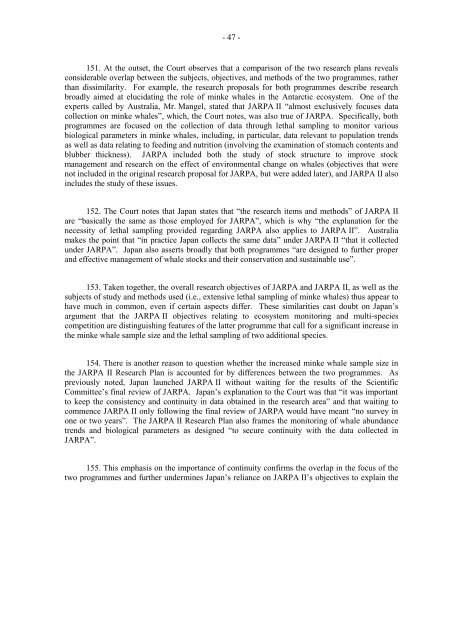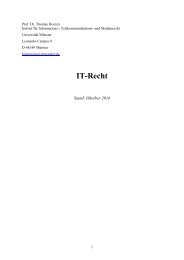3d4yVkKMl
3d4yVkKMl
3d4yVkKMl
Create successful ePaper yourself
Turn your PDF publications into a flip-book with our unique Google optimized e-Paper software.
- 47 -<br />
151. At the outset, the Court observes that a comparison of the two research plans reveals<br />
considerable overlap between the subjects, objectives, and methods of the two programmes, rather<br />
than dissimilarity. For example, the research proposals for both programmes describe research<br />
broadly aimed at elucidating the role of minke whales in the Antarctic ecosystem. One of the<br />
experts called by Australia, Mr. Mangel, stated that JARPA II “almost exclusively focuses data<br />
collection on minke whales”, which, the Court notes, was also true of JARPA. Specifically, both<br />
programmes are focused on the collection of data through lethal sampling to monitor various<br />
biological parameters in minke whales, including, in particular, data relevant to population trends<br />
as well as data relating to feeding and nutrition (involving the examination of stomach contents and<br />
blubber thickness). JARPA included both the study of stock structure to improve stock<br />
management and research on the effect of environmental change on whales (objectives that were<br />
not included in the original research proposal for JARPA, but were added later), and JARPA II also<br />
includes the study of these issues.<br />
152. The Court notes that Japan states that “the research items and methods” of JARPA II<br />
are “basically the same as those employed for JARPA”, which is why “the explanation for the<br />
necessity of lethal sampling provided regarding JARPA also applies to JARPA II”. Australia<br />
makes the point that “in practice Japan collects the same data” under JARPA II “that it collected<br />
under JARPA”. Japan also asserts broadly that both programmes “are designed to further proper<br />
and effective management of whale stocks and their conservation and sustainable use”.<br />
153. Taken together, the overall research objectives of JARPA and JARPA II, as well as the<br />
subjects of study and methods used (i.e., extensive lethal sampling of minke whales) thus appear to<br />
have much in common, even if certain aspects differ. These similarities cast doubt on Japan’s<br />
argument that the JARPA II objectives relating to ecosystem monitoring and multi-species<br />
competition are distinguishing features of the latter programme that call for a significant increase in<br />
the minke whale sample size and the lethal sampling of two additional species.<br />
154. There is another reason to question whether the increased minke whale sample size in<br />
the JARPA II Research Plan is accounted for by differences between the two programmes. As<br />
previously noted, Japan launched JARPA II without waiting for the results of the Scientific<br />
Committee’s final review of JARPA. Japan’s explanation to the Court was that “it was important<br />
to keep the consistency and continuity in data obtained in the research area” and that waiting to<br />
commence JARPA II only following the final review of JARPA would have meant “no survey in<br />
one or two years”. The JARPA II Research Plan also frames the monitoring of whale abundance<br />
trends and biological parameters as designed “to secure continuity with the data collected in<br />
JARPA”.<br />
155. This emphasis on the importance of continuity confirms the overlap in the focus of the<br />
two programmes and further undermines Japan’s reliance on JARPA II’s objectives to explain the



